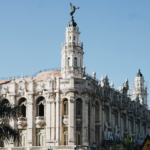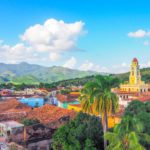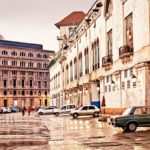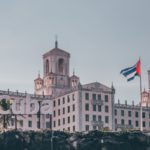Necrópolis Cristóbal Colón, also known as Christopher Columbus Cemetery, is one of the largest and most impressive cemeteries in the world.
In Havana, Cuba, this historic cemetery is a popular destination for tourists who want to explore the city’s rich history and culture.
In this guide, we will provide an overview of Necrópolis Cristóbal Colón, including its history, notable tombs and mausoleums, and tips for visiting.
What is Necrópolis Cristóbal Colón?
Necrópolis Cristóbal Colón, also known as Christopher Columbus Cemetery, is a historic cemetery in the Vedado neighborhood of Havana, Cuba.
It was established in 1876 and covers an area of approximately 140 acres. This makes it one of the largest cemeteries in the world.
The cemetery is named after Christopher Columbus, the famous explorer who is said to have discovered Cuba during his travels to the New World.
Over the years, Necrópolis Cristóbal Colón has become a popular tourist attraction. This is due to its impressive architecture, elaborate tombs and mausoleums, and the many notable figures buried there.
The history of Christopher Columbus Cemetery
The history of Necrópolis Cristóbal Colón dates back to the late 19th century when the city of Havana was experiencing a period of rapid growth and development. At the time, the city’s existing cemeteries were becoming overcrowde. There was a need for a new cemetery that could accommodate the growing population.
In 1868, the Spanish colonial government purchased a large tract of land in the Vedado neighborhood of Havana with the intention of creating a new cemetery. Construction on Necrópolis Cristóbal Colón began in 1871 and was completed in 1876. The cemetery was designed by Calixto de Loira y Cardoso, a Spanish architect who was also responsible for several other prominent buildings in Havana.
A reflection of Cuba’s diverse cultural heritage
From its earliest days, Necrópolis Cristóbal Colón was a reflection of Cuba’s diverse cultural heritage. The cemetery was designed to accommodate a variety of religious and cultural traditions, with separate sections for Catholic, Protestant, Jewish, and Chinese burials. Over the years, the cemetery became a final resting place for many of Cuba’s most prominent citizens, including politicians, artists, musicians, and writers.
During the 20th century, Necrópolis Cristóbal Colón fell into a state of disrepair due to a lack of funding and resources. However, in recent years, efforts have been made to restore and preserve the cemetery’s many historic tombs and monuments, making it a popular destination for visitors to Havana who are interested in exploring the city’s rich cultural heritage.
Notable tombs and mausoleums
Necrópolis Cristóbal Colón is home to a vast number of notable tombs and mausoleums, many of which are considered works of art in their own right. Here are some of the most famous ones:
La Milagrosa
The tomb of Amelia Goyri de Adot, who died in 1903 during childbirth. Her husband, Desiderio Adot, had her body embalmed and placed in a glass-covered coffin so that her son could visit her. It is said that her body remains incorrupt, and she is considered a miraculous figure by many Cuban Catholics.
The Bacardi Mausoleum
A grand Art Deco-style mausoleum built in 1926 by the Bacardi family, who were famous for their rum-making business. The mausoleum features a large bronze statue of the Bacardi family’s founder, Don Facundo Bacardi, and is one of the most impressive monuments in the cemetery.
The Martí Mausoleum
The final resting place of José Martí, one of Cuba’s most famous independence heroes and writers. The mausoleum features a statue of Martí surrounded by several of his famous quotes.
The Galician Pantheon
A grand mausoleum that serves as a tribute to the Galician immigrants who settled in Cuba during the late 19th century. The mausoleum features several large sculptures and intricate carvings.
The Chinese Cemetery
A section of the cemetery for the burials of Chinese immigrants who settled in Cuba during the 19th century. The cemetery features several impressive monuments and is a testament to the cultural diversity of Havana.
These are just a few of the many notable tombs and mausoleums at Necrópolis Cristóbal Colón. Visitors to the cemetery are sure to marvel at the stunning architecture and rich history throughout the grounds.
Tips on visiting
If you’re planning a visit to Necrópolis Cristóbal Colón, here are some tips to make the most of your experience:
- Wear comfortable shoes and bring water – The cemetery is quite large and can take several hours to explore. So it’s important to wear comfortable shoes and bring plenty of water.
- Consider hiring a guide – A guide can provide valuable insight into the cemetery’s history and architecture. He or she can help you navigate the vast grounds.
- Bring a map or guidebook – A map or guidebook can help you find the most notable tombs and mausoleums. It’ll be easier to navigate the cemetery’s many winding paths.
- Respect the graves – It’s important to remember that a cemetery is a place of mourning and remembrance. So, treat the graves and monuments with respect.
- Visit during daylight hours – The cemetery is open from early morning until late afternoon. It’s best to visit during daylight hours for safety reasons.
- Take your time – Necrópolis Cristóbal Colón is a truly unique and fascinating place. It’s best to take your time and explore the grounds at a leisurely pace. Allow yourself plenty of time to soak in the history and architecture of this incredible site.
Visiting Necrópolis Cristóbal Colón
So there you have it: Necrópolis Cristóbal Colón is a remarkable and historic cemetery in Havana, Cuba. With over 800,000 graves and mausoleums, it’s the final resting place of some of Cuba’s most notable citizens. Plus, it’s a fascinating testament to the country’s rich history and culture. Whether you’re a history buff or simply want to explore one of Havana’s most unique attractions, a visit to Necrópolis Cristóbal Colón is well worth the trip.
- The Art of Cuban Poster Design: History, Techniques, and Cultural Significance - May 23, 2023
- Taking A Vintage Car Tour In Havana - May 23, 2023
- Top 5 Cuban Revolutionary Sites - May 23, 2023








